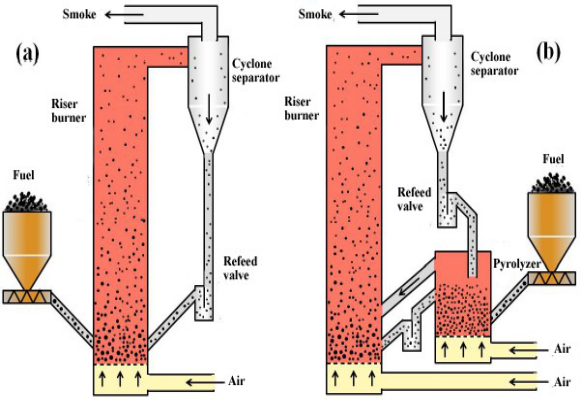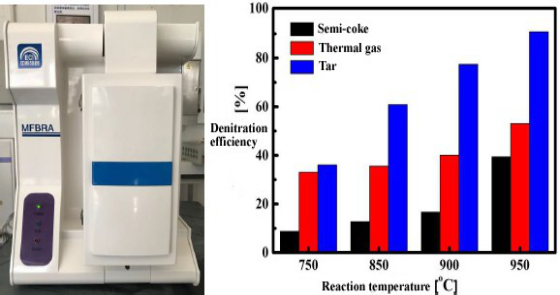Technical principle
Technology of double fluidized-bed decoupling combustion is a new type of combustion technology developed by institute of process engineering of Chinese Academy of Sciences, the technique decouples the fuel combustion process into two sub-processes of fuel drying / pyrolysis and pyrolysis products combustion, optimizing combustion is made according to principle of re-combustion, thus, wide range of adaptation, low pollutant emissions and other effect can be achieved for fuel
Figure 1 is principle comparison chart of traditional conventional circulating fluidized bed combustion and double fluidized bed decoupling combustion. Figure 1(a) is schematic diagram of circulating fluidized bed combustion, it is mainly including riser burner, cyclone separator and refeed valve. The fuel is fed from the bottom of the riser and mixed with high temperature circulating bed material from refeed valve, temperature rises rapidly and it exposes air for combustion and releasing heat. After separation by cyclone separator, unburned fuel and circulating bed material return to riser through refeed valve. Figure 1(b) is schematic diagram of double fluidized-bed decoupling combustion, it mainly is including riser burner, fluidized-bed pyrolyzer, cyclone separator and refeed valve. The fuel is first fed by the pyrolyzer, mixed with high temperature circulating bed material from refeed valve, and temperature rises rapidly, dry and pyrolysis reaction occurs, generated semi-coke enter bottom of the riser for combustion and heat release through refeed valve, gas product enters the riser through the gas pipe. Pyrolysis of semi-coke does not contain water, this eliminate impact of high water content of raw materials on the combustion process; The reduction components of the pyrolysis gas product (such as H2, CH4, CO and tar) can reduce the NOx produced by combustion to N2, thus, low NOx emission can be achieved. After the combustion and cyclone separation, unburned fuel and recycled bed material return to the pyrolyzer through by refeed valve.

图 1.循环流化床燃烧与双流化床解耦燃烧原理图:(a)循环流化床燃烧 (b)双流化床解耦燃烧
Figure 1:Schematic diagram of circulating fluidized-bed combustion and double fluidized-bed decoupling combustion: (a)circulating fluidized-bed combustion(b)double fluidized-bed decoupling combustion
It can be proved that NOx can be reduced by pyrolysis products through re-burning, pyrolysis and combustion optimization can achieve high moisture fuel combustion and low NOx emissions. Figure 2 is comparison of denitrification efficiency achieved by different pyrolysis products. The experimental device is a micro fluidized bed reaction analyzer. The pyrolysis products have different reduction effect on NOx due to the figure, and the denitrification efficiency will increase with increase of reaction temperature. Denitrification capacity of pyrolysis products: tar>pyrolysis gas>semi-coke.

Figure 2: Comparison of denitration efficiency of different pyrolysis products
Technicaladvantages
(1) It is suitable for raw material with high water content
As for double fluidized bed decoupling combustion technology, The high water content fuel shall firstly pass through a pyrolysis process, a semi-coke and pyrolysis gas without water content are produced, therefore, this eliminate impact of high water content during the combustion process, it is applicable to fuels with a moisture content of up to 40 wt.%. Adapted biomass waste fuel must be pre-drilled in advance for chain furnace of traditional distiller's grain and circulating fluidized bed burner, such as water content is less than 20%, otherwise, burning difficulties, incomplete combustion, emissions of smoke and other issues will be generated.
(2) Low NOx emission
Double fluidized bed decoupling combustion technology uses pyrolysis gas and tar produced by the pyrolysis of fuel itself as re-burning fuel to reduce the NOx generated by the combustion. The NOx concentration in the flue gas is not higher than 50 ppm, without any denitrification facilities, emission standards set by environmental protection departments can be met.
(3) High thermal efficiency of system
As for high water content fuels (60 wt.% Or more), double fluidized bed decoupling combustion technology is applicable to fuels with a moisture content of up to 40 wt.%, mild dry can meet the requirements; While the traditional combustion technology can only deal following fuels with less than 20 wt.% water content, deep dry is a must. Pipe dry or paddle dry is common in industry, if one ton water is dried in a day, amount of steam is between 1.3 and 1.4t, there is much more energy consumption. Thus, double fluidized bed decoupling combustion technology can greatly decrease dry energy consumption, the system has higher efficient thermal efficiency.